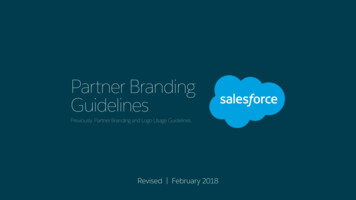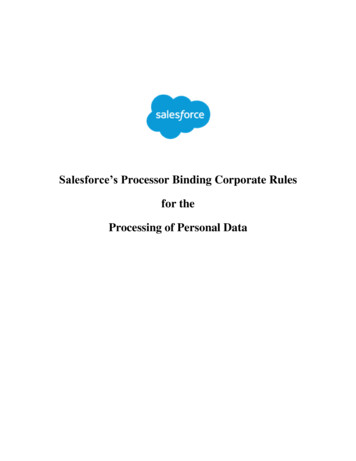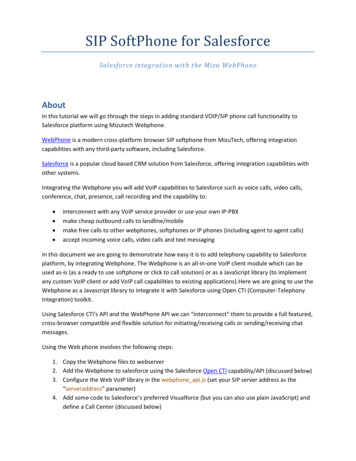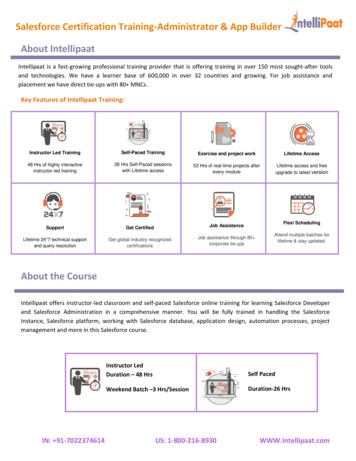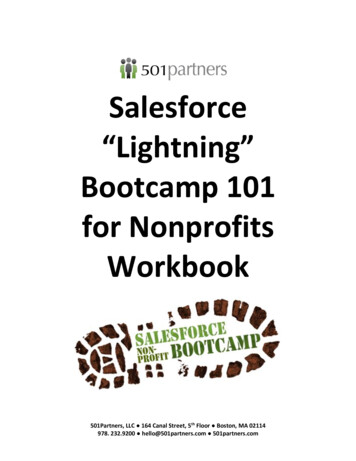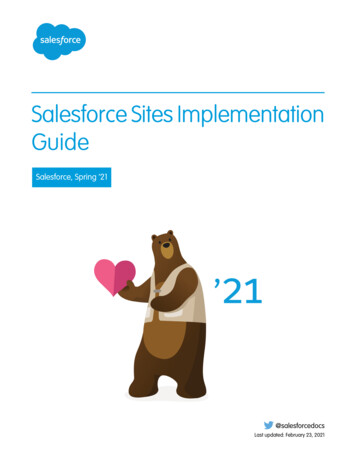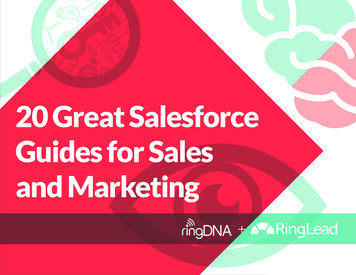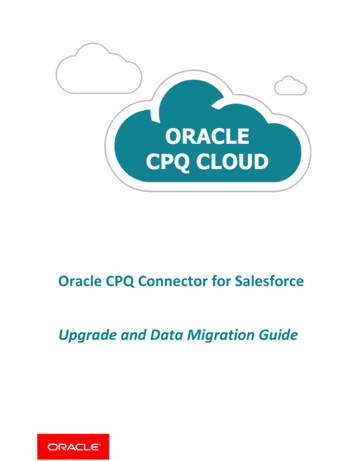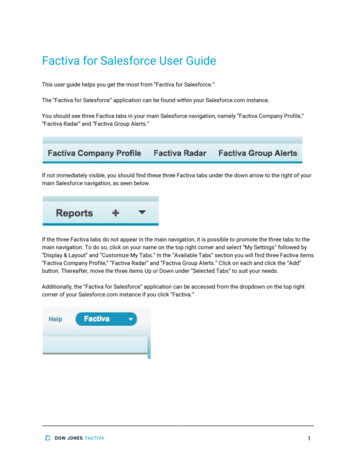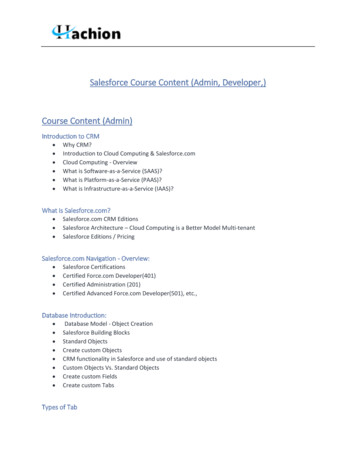
Transcription
Salesforce Course Content (Admin, Developer,)Course Content (Admin)Introduction to CRM Why CRM?Introduction to Cloud Computing & Salesforce.comCloud Computing - OverviewWhat is Software-as-a-Service (SAAS)?What is Platform-as-a-Service (PAAS)?What is Infrastructure-as-a-Service (IAAS)?What is Salesforce.com? Salesforce.com CRM EditionsSalesforce Architecture – Cloud Computing is a Better Model Multi-tenantSalesforce Editions / PricingSalesforce.com Navigation - Overview: Salesforce CertificationsCertified Force.com Developer(401)Certified Administration (201)Certified Advanced Force.com Developer(501), etc.,Database Introduction: Database Model - Object CreationSalesforce Building BlocksStandard ObjectsCreate custom ObjectsCRM functionality in Salesforce and use of standard objectsCustom Objects Vs. Standard ObjectsCreate custom FieldsCreate custom TabsTypes of Tab
Standard Objects – Account, Contacts, Leads, Campaigns, Opportunities etc.,Custom object TabsWeb TabsVisual force TabsCustom Application: LimitationsField Creation and its Relationships a. Different Data typesStandard Data types: Text, Email, Number, Currency, URL, Text Area.Storage LimitationsRead only Data types: Auto Number, Formula and Rollup summaryRollup summary OperationsSum(), Min(), Max() and CountRelational Data types: Lookup Vs. Master - Detail RelationshipLimitationsRequired, External Id, Default Value and Unique fieldsSalesforce Application elements:Home Page, Tabs, Tab Home Pages, Detail Page, Side Bar, Apps, RecordPage Layouts: Defining Page layoutsField order changesAdding custom buttons and linksDefining required and read only fieldsAdding related listRecord Types: To create and maintain record types for your organization.Display different page layouts and picklist values based on record types.Uses of Record TypesField Dependencies: Controlling field/Dependent field?Making dependent pick list fieldsLimitations
Validation Rules: Defining Salesforce Data ValidationCreating Custom Validation RulesValidation Vs. TriggerWorkflow rules: Define workflowCreate Email templateSet up workflow rulesSet up workflow actionsWorkflow Approval process: Plan approvals using workflowUse the approval wizard – standard vs. jump startCreate workflow approvalsEmail Templates: Email Templates – Sending Single emails and Mass emails.Types of Templates - HTML (Using Letter Head) , Custom HTML (without using letter head), Visualforce Email TemplatesData Management: Import Wizard Vs Data LoaderImporting OverviewExporting OverviewImport custom object records using the Data LoaderUse mass deleteUse storagePersonal Setup: Managing Personal InformationPassword ResetUser Management OverviewRoles, Users, Profiles & SharingUsers, Roles and Profiles: Creating UsersUser Licenses OverviewUnderstanding Record Ownership and AccessRole HierarchyProfilesOverview and different profilesUser Permissions
Security: Managing the UsersSet Organization Wide Defaults (OWD)Object-level SecurityField-level SecurityRecord-level SecuritySharing Rules1.2.Define Sharing rulesDiscuss about types of sharing rulesReports & DashboardsAppExchange: Installing an AppUninstalling an AppCourse Content (Developer)Description Don't know what Salesforce is?Use Salesforce but don't know all the products that Salesforce has to offer?Want to know how much you could learn working with Salesforce products?Confused by all the Salesforce certifications?If so, then this is the course for you! This course is for anyone new to Salesforce and wanting tounderstand what it is and the products Saleforce sells. By the end of the course you will understandthe Salesforce cloud services, the Salaries you could achieve working in Salesforce, as well as thecertifications available to you and which ones you may wish to start with based on yourbackground. I will also go through a short history of Salesforce to show how it all began and evolvedover the years.You don't need any previous experience with Salesforce.Who this course is for: Anyone who has heard of Salesforce and wants to know what it is? Anyone wanting to know what Salaries you maybe able to get working in Salesforce Those people wanting to have an overview of the Certifications and which to start first.Course Content
What Made Salesforce An Instant Hit?The answer to this is very simple, it was Cloud Computing. Salesforce wasn’t just about a betterproduct at a fraction of the cost. It was about replacing the lengthy installation process and movingeverything to the internet. They changed the business model – no more long-term contracts orexpensive licensing deals, anyone could use Salesforce with only a simple 50-dollar monthlysubscription fee.Why Salesforce?Before I answer the question, what is Salesforce, let me brief you about why you should chooseSalesforce. As seen in the above image, Salesforce provides you with the fastest path from Idea to App.You can concentrate on building your app using Salesforce tools, rather than building theinfrastructure and tools yourself. This can save you years of time and millions of dollars.Salesforce customers generally say that it’s unique for three major reasons:Fast – Traditional CRM software can take more than a year to deploy, compare that tomonths or even weeks with Salesforce.Easy – Salesforce wins in the easy to use category hands down. You can spend more timeputting it to use and less time figuring it out.Effective – Because it is easy to use and can be customized to meet business needs,customers find Salesforce very effective.Salesforce is in the cloud, so your team can use it from anywhere with access to theinternet.If you are a business that is rapidly changing or you are a seasoned company that’s beenaround for years, your business is probably changing too. Salesforce is completely scalableto your growth.Salesforce seamlessly integrates with 3rd party apps. If you want to integrate Salesforcewith Gmail you can do it, if you want to integrate it with your accounting software you cando that too. On the other hand, integration is tough with other CRMs.Salesforce is affordable, especially if you consider its vast variety of capabilities. Evenstartups and small business can use Salesforce.Statistics which make you choose SalesforceAs of May 2016, Salesforce has had over 150,000 customers across the world. In the world of CRM,Salesforce dominates with a 19.7% market share. Its closest competitors SAP (12.1%), Oracle (9.1%)and Microsoft (6.2%) are far behind. The Salesforce AppExchange features over 2,700 applicationswhich has driven a total of over 3 million installations and more than 70% of Salesforce customersuse applications that are listed on the AppExchange. Today, many companies are developing theirapplications on Salesforce platform or are migrating to Salesforce. This has increased the demand
for Salesforce developers and administrators. Currently, Salesforce Architect is one of the hottestskills to have on a tech resume.What Is Salesforce?I hope I have answered your question on why you should choose Salesforce. Now, let me introduceyou to Salesforce and answer the question on your mind: What is Salesforce? Below is an imagewhich shows the power of Salesforce in today’s tech-savvy world. From tech giants like Google andFacebook to your nearby call center, all of them use Salesforce services and products to solve theirproblems.Salesforce started as Software as a Service (SaaS) CRM company. Salesforce now provides varioussoftware solutions and a platform for users and developers to develop and distribute customsoftware. Salesforce.com is based on multi-tenant architecture. This means that multiple customersshare common technology and all run on the latest release. You don’t have to worry about theapplication or infrastructure upgrades – they happen automatically. This helps your organizationfocus on innovation rather than managing technology.What Are The Services And Products That Salesforce Offers?To understand what is Salesforce, you need to know the different services and products thatSalesforce has to offer and when to use them. Through Salesforce, you can access a wide range ofproducts and services in Cloud, Social and Mobile domains. Below is an image that shows thedifferent services and products that Salesforce offers to its customers.Salesforce Admin 201 and App Builder Course ContentFundamentals of Salesforce CRM basics and cloud computing Salesforce.com overview and foundation Salesforce platform, Salesforce terminology, and introduction to force.com platform Multi-tenancy and cloud Salesforce metadata and APIs Salesforce architecture The functionality of a central CRM object in Salesforce schema Determining declarative custom restrictions and programmatic custom use cases in a givenscenario Declarative vs. Programmatic customizations Identify common scenarios for using the AppExchange extension organization OOP programming and database connections in PythonData Modeling and Management Identify appropriate data models in a given scenario
Capabilities of different relationship types and the impact of each record access, reporting,and user interface.Identify considerations for changing the field type. Determine considerations and select theappropriate field type based on many requirements.Describe the features and considerations of the schema builder.Illustrate options and considerations for importing/exporting data.Describe the features and use cases of external objects under Salesforce.Trust, data model, field and relationship fields.Pattern generator, junction object, and business logic.Salesforce data management, data import wizard and data loader.Export data, Apex class variables, and methods.Class constructor, Apex, and access modifier.Apex development tools, development process, and governor boundaries.Backing up and sharing data Describe the available features and ways to limit and extend objects, field access, andrecords Identify appropriate release solutions based on many business needs Salesforce application development tools Application development strategy using AppExchange Search and navigate Salesforce documentsBusiness logic & process automationDescribe the function and use case of: Record typeFormula fieldsOf roll-up summary fieldsValidation rulesApproval processWorkflow, visual workflow and Lightning process builderWorking with Chatter Chatter featuresChatter use casesAnalyze data using reports and dashboards Report type and dashboardIdentify the features available when creating a report
Salesforce development Describe development considerations in a multi-tenant environmentDescribe how the Salesforce platform features map to MVC patterns, sharing, ‘this’keyword, inheritance, and interfaces.System classes/methods, field API names, and standard objects.Relationships in Apex; basic SOQL syntax, functions, variable binding, keywords, relationalqueries, and SOQL-for-loops, SOQL Debugging with debug logs, and anonymous blocking.SOSL and SOSLDebugging toolsApex testing, testing classes, and unit testingSystem testing class methodsTest classes, test data, unit testing using private variables and methodsIntroduction to Apex Code Language constructs declaring variables & constants in Apex and assigning values using thevarious expressionsCollection overview (lists, collections, and mappings), calling Apex, classes, interfaces, andobjectsUse and application of Apex control flow instructionsUsage of basic SOSL, DML statements, and SOQLApex design, dynamic and batch ApexDebug Apex, manage debug logs, and anonymous scriptsDeveloper console, Force.com IDE, and workbenchSaveResult classes, DML (Data Manipulation Language)DML & loop, DML options, Database, and transaction controlSOQL and governor restrictionsApex triggers and execution orderTrigger context variables; create and display triggersRecognize trigger events, helper class patterns, and batch triggersHandle recursion in triggers, using addError() and Apex trigger best practices to limitmemory operationsExceptions, exception methods, and system-defined exceptionsHandle user-defined or custom exception and intercept various exception typesApex Triggers Governor limits, start/stop use, test ApexBulkified code, test framework, create/load test dataUse system.runAs to test configuration file security
Visualforce Describe how to write a Visualforce controller using JavaScript / HTML / CSSUse standard Visualforce controllers and custom Apex controllers/controller extensionsVisualforce page, build method, development tool, tags, and their binding types & syntaxUnderstand the MVC patternStatic resources in VisualforceSalesforce Lightning overviewLightning component framework structure and its benefitsSalesforce Lightning Salesforce Lightning tools and technology collectionsWhat is a Visualforce controller - standard controller, list controller?Custom controllers;custom list controllers, methods, extensions, and execution orderSpeed optimization of modern user interface speed optimizationSalesforce Lightning experience and create reusable components to customize itSalesforce1 mobile applicationSalesforce1 Lightning Process Builder Salesforce1 Introduction and its action layoutLightning process builderUse a visual layout to create a process and establish the entire process instead of usingmultiple workflow rulesCollaborating for different users in the user interfaceSign-up of Salesforce account Two free accounts, one-lifetime free developer account, one 30-day trial productionaccount, a registered lifetime developer account, and an account created athttps://developer.force.comSalesforce domain registration Create custom Salesforce domainDefine the organization's custom domain name on https:// .lightning.force.com and test thedomainEvent-driven Lightning framework & Aura frameworkDeploy the domain using the developer console to create a lightning componentUse HTML and CSS styles Style Lightning components using HTML and CSS
See the components in the Lightning AppUse the developer console to create a CSS fileLink tothe lightning component and upload an external style sheet to a static resourceAttributes of Lightning component Understand Apex class’s attributes and member variablesTyped fields for component instancesUse expression syntax to reference from component tagsUse attribute dynamic componentsAdd attributes to a component or application using the aura:attribute tag.Lightning functions Client controller, functions, and Binding componentsPass values and JavaScript-based operationsApplication attributes and reference components in the applicationComponent Composition Learn to create:Simple components such as c:LC and c:LC2Fine-grained components in larger components by assembling each componentWrapper component with simple components.Conditional Statements Conditional If-else statement, isTrue expression, aura:if, component instantiating in its bodyor in the Else attributeUse of Value Providers Use value providers to access data, combine related values, component v (view) and c(control) value providers.Out-of-the-box components Use out-of-the-box Salesforce1 componentsLightning experience and its applicationsDifferent namespaces components, Force, Force Community, Aura, Force Chatter, etc.Style Lightning system, user interface, and namespace componentGeneric UI & UI namespace Universal user interface, use of aura: components, UI components
Handle common user interfaces and component extensions & designsDynamic update of UI components Dynamic update of UI componentsTrigger JavaScript controller actions for events in Lightning componentEvent declarations with aura:event tagHandling events JavaScript and Java Swing for event-driven programming,Component and application eventsWrite JavaScript controller actions handlersServer-side controller Create a server-side controller in Apex, Aura annotationAnnotation that allow server-side and client access to controlled methodsInvoke server-side controller operations from the client controllerServer-side controller hands-on A real-world example of fetching data from an opportunity object via server-side controllerdeploymentCreate the client controller to call the server-side controller and pass the returned value tothe componentCreate a Lightning application Create a contact management app on the Lightning FrameworkUpload CSS files and upload them to static resources for reference in the appCreate a contact-controller Apex classRetrieve data from contacts and return to the contact listDesign user interfaces using HTML & CSS classes provided in the style sheet (bootstrap)Salesforce Lightning Project Create a component to call the client controller function and process the dataRetrieve the contact details as per the IDCreate a component to handle the eventCreate a client controller to bind the user eventCall the Apex controller methodAdd fields & queries to the componentsAnd displays them on the screen
Salesforce Course Content (Admin, Developer,) Course Content (Admin) Introduction to CRM . Sending Single emails and Mass emails. Types of Templates - HTML (Using Letter Head) , Custom HTML (without using letter head), Visual . Describe the available features and ways to limit and extend objects, field access, and records .
